This was published 1 year ago
A look under the bonnet of the No campaign isn’t a pretty sight
When leading No campaigner Warren Mundine revealed during a radio interview this week that he had rejected two potential volunteers for making racist remarks, it was the latest in a string of racially infused scandals to hit the anti-Voice campaign.
Mundine made the disclosure as he distanced himself and the No campaign from tweets by Australian Jewish Association head David Adler, who sits on the advisory board of top No outfit Advance, suggesting Indigenous journalist Stan Grant artificially darkened his skin and questioning Victorian senator Lidia Thorpe’s Aboriginal heritage.
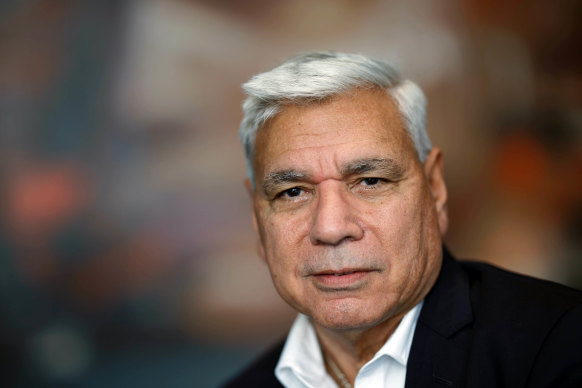
Prominent No campaigner Warren Mundine has had to sack volunteers due to racist comments.Credit: Trevor Collens
For months, the nasty recesses of Twitter (now X) have been awash with accounts pushing a barrage of tweets questioning Grant’s skin tone. But Adler’s decision to join the trolling online – with tweets from earlier this year resurfacing this week including one that read “Is Stan Grant doing ‘black face’” – allowed a direct link to be drawn from the conspiratorial fringes to the No campaign.
Only weeks earlier, Mundine had been called upon to respond to views held by another leading No campaign figure Gary Johns, an ex-Labor minister who suggested blood tests should be taken to prove a person’s Aboriginality to access welfare benefits. Amid a storm of outrage from Yes advocates and calls for Johns to be dumped, Mundine and Coalition frontbencher Jacinta Nampijinpa Price, who is a key spokesperson for the No campaign, defended Johns’ role in the No team, saying he was entitled to his views.
In an interview, Mundine dismissed the commentary by Adler and Johns as “noise on the side” and said it wouldn’t harm the No campaign, though he labelled Adler’s tweets “stupid” and said he’d privately rebuked Johns.
“Gary knows how I feel about that and I presume his ears are still ringing,” Mundine said. “When you’re talking about the referendum, these [issues] don’t affect it. The vast majority of Australians are looking at the referendum in two parts.
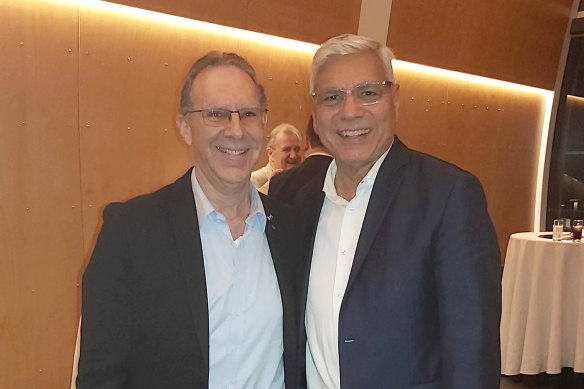
Warren Mundine and David Adler. Mundine has called Adler’s tweets “stupid”.Credit: Twitter
“They want to see Aboriginal and Torres Strait Islanders in the Constitution as recognising the first people of this country. The second part is they are sick and tired of all these issues and all these problems that are happening in Aboriginal communities when billions of dollars have been spent on it.”
Johns and Adler have previously stood by their comments and resisted calls to apologise.
While the Peter Dutton-led federal opposition is not running the No campaign, there is a direct conduit between the two via Price’s role as the face of Advance’s anti-Voice campaign, called Fair Australia.
But there is little sign that the No camp’s stumbles are blowing back on the Coalition, with Dutton brushing off calls from Attorney-General Mark Dreyfus this week to “start dissociating himself from this kind of material ... the kind of hateful, revolting material that we’ve seen from people like Mr David Adler.”
Price did not respond to a series of questions, including whether she had raised any concerns with the Advance team about Adler’s remarks and his role on the advisory board, or whether she was concerned the views held by him and Johns risked driving away soft No or undecided voters turned off by such commentary. Dutton also did not respond to a similar set of questions.
Advance, a conservative activist group that also has former prime minister Tony Abbott on its advisory board, declined to comment about Adler’s role in the organisation, saying: “As a rule, we do not comment on the campaign.”
Former liberal strategist Tony Barry, a director of political consultancy firm RedBridge Group, which has been conducting polling and focus groups on the Voice, doubts the No campaign’s scandals will have much impact on the strength of the No vote or tarnish the Liberal brand by association.
“Both campaigns have had issues with message discipline,” Barry said. “But the Yes campaign have the more difficult job of trying to sell a product to people while the No campaign only has to convince people not to buy.
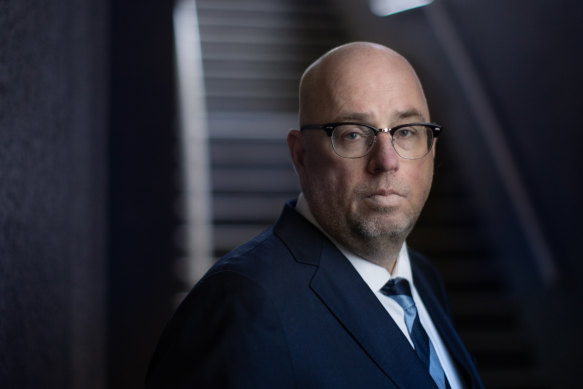
Former Liberal strategist Tony Barry says the yes vote has the harder task.Credit: Simon Schluter
“At this stage of the cycle, the No campaign are doing a better job by defining the perceived risks of the Voice and are mostly sticking to their two strongest arguments – detail and division – which we know from the polling works.
”In our research, we are finding the majority of voters are so overwhelmed by cost-of-living and housing pressures that they are very disengaged on the referendum – and in the absence of any detail or a compelling reason to vote Yes, they are defaulting to a No vote consideration.“
Multiple Liberal MPs from the party’s conservative and moderate wings, who spoke on the condition of anonymity, said they were not worried that voters would associate the party with the views expressed by Adler and Johns.
“If there were people in the Liberal and National Party staying that sort of stuff, I’d be deeply concerned,” one Liberal said. “But you can’t say everyone campaigning for No believes those things.”
Another senior Liberal said: “I’m less concerned about brand damage to the party and more concerned about ‘how do those sorts of comments help us win the campaign’.”
There has been intense scrutiny on the shortcomings of the Yes campaign as numerous polls have laid bare the plunge in support for the Voice referendum as advocates and federal ministers have struggled to make the case that a constitutionally enshrined body will deliver real, practical improvements to the lives of Aboriginal Australians.
The latest Resolve Political Monitor survey showed the referendum is on track for defeat, with support for the Voice slipping further this month from 48 to 46 per cent, while the results indicated it only had majority support in Victoria and Tasmania and is opposed in NSW, Queensland, Western Australia and South Australia.
But a cursory look under the bonnet of the No campaign reveals an at-times chaotic operation, that fuses together contradictory positions and is well-practised in the dark arts of campaigning.
The No group emerged as a single outfit at the start of the year called Recognise a Better Way, launched by Mundine and Price, with a six-member committee that included Johns as president. It proposed an alternative to the Voice that would see symbolic constitutional recognition of Indigenous people and migrants through a new preamble – something that was immediately rejected by peak migrant groups.
Within weeks, Price split from the campaign to head up Advance’s separate No push, only for Mundine to announce months later that they had re-merged some of their campaign functions and financing under a new “Australians for Unity”.
“We work together, we centralise some stuff, and we do some things together and separately,” Mundine says.
Mundine’s decades-long support for local treaties between governments and Indigenous people is also at odds with the Recognise a Better Way campaign he leads. A position paper on the campaign’s website states that “treaties kill reconciliation” and “national unity around the equality of each citizen would be destroyed by any treaty mechanism”.
Asked to explain the inconsistency, Mundine says: “This is how we operate. If anyone knows Warren Mundine they know me as a bloke who speaks his mind.”
The Price-led Fair Australia campaign run by Advance has also come under scrutiny for its campaign tactics. Led by Matthew Sheahan, Advance claims it has a 250,000-strong supporter base fighting “woke politicians and elitist activist groups … taking Aussies for a ride with their radical agenda”.
It is behind two distinctly different anti-Voice Facebook pages, one Referendum News, which provides a feed of links of mostly negative news and commentary on the Voice. The other, called Not Enough, promotes the arguments of so-called “progressive No” voters such as Lidia Thorpe who say the Voice should be rejected because it will be powerless.
Advance defended its social media strategy to Guardian Australia last month, saying “we absolutely reject the incorrect assertion that these social media campaigns are in any way misleading”.
Advance also came under heavy criticism last month for a newspaper ad that depicted a cartoon portrayal of Yes campaigner Thomas Mayo, who appeared to be dancing for money, which was widely condemned as racist. Advance stood by the ad while The Australian Financial Review, which published it, apologised.
In another incident, Advance was forced to remove the image and testimonial of Indigenous man Stewart Lingiari from the Fair Australia website which claimed that he was Vincent Lingiari’s grandson and was supporting the No campaign. The man publicly rejected any family connection to the land rights activist and claimed he didn’t know what the Voice was.
On another occasion, AAP FactCheck concluded an email sent by Fair Australia to its supporters, authored by Price, was “misleading” in its claims to have uncovered “secret” government documents that exposed the “real agenda” behind the Voice referendum.
In the email, Price asserts “the Voice forces Australians into a ‘treaty’” which “means Australians pay a percentage of the GDP – that is, a percentage of the entire nation’s economy – to the Voice … every year”. It found the documents were minutes from 13 consultation events held in 2016 and 2017 about constitutional recognition and reflected comments made by some attendees, not positions adopted by the government.
Labor and the Yes camp have attempted to call out the No campaign tactics, but with limited success, with their criticism feeding into a seemingly endless loop of outrage and sucking oxygen from their core message.
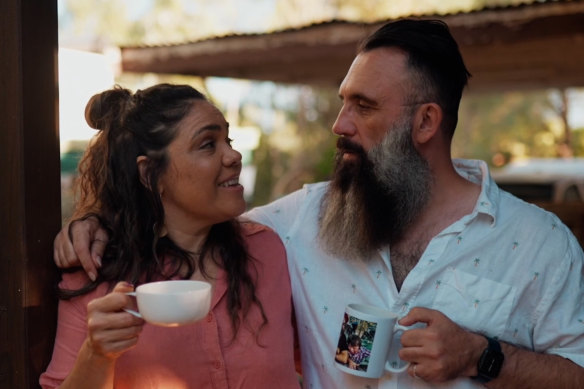
Jacinta Nampijinpa Price and husband Colin Lillie in a No campaign video.Credit: Screenshot
Indigenous Australians Minister Linda Burney last month accused Fair Australia of using “Trump-style politics” in its campaign against the Voice, alleging its aim was “to polarise, [and] to sow division in our society by making false claims”.
But this was seized on by critics as denouncing No voters, while conservatives compared the remarks to Hilary Clinton’s labelling of Trump voters as a “basket of deplorables”.
This week, Yes campaigner Marcus Stewart, from the Uluru Dialogue, attacked the No campaign during an interview with the ABC, saying its rhetoric was “doing serious damage to our community”.
He singled out Price, accusing her of “spreading lies” and misinformation about the Voice and suggested she “seems to hate Aboriginal and Torres Strait Islander people”.
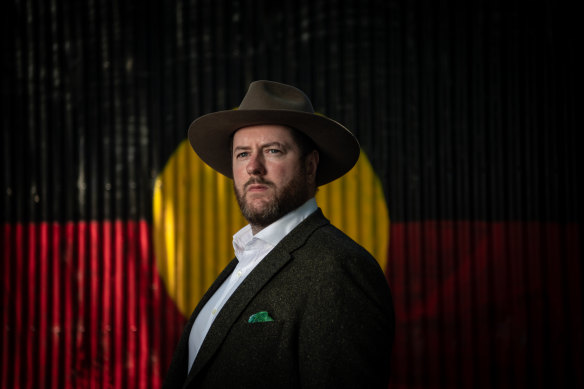
Marcus Stewart’s attack on Jacinta Price elicited fury.Credit: Justin McManus
The remarks were met with fury within Liberal and No campaign circles. Dutton demanded an apology, while Yes 23 campaign director Dean Parkin sought to distance the campaign from the comments, telling the ABC, “we certainly disagree with those comments”. Price, meanwhile, told 2GB “this reeks of desperation from the Yes campaign”.
Essential pollster Peter Lewis, whose research is published in the Guardian Australia and who is working with the Yes 23 campaign, said there was an “absolute mismatch” between the two campaigns in terms of the strength of their networks, likening the No camp to a “bunch of lone riders”.
In contrast, the Yes campaign has the backing of many Indigenous leaders, sporting groups, churches, unions and many big businesses, which have contributed to a war chest in the tens of millions of dollars.
But Lewis says the combination of media coverage and digital platforms was eradicating much of that mismatch, and No was benefiting enormously from having Aboriginal spokespeople in Mundine and Price to sell their message that the Voice was not universally backed by Indigenous Australia.
“People hear division among Indigenous people. Warren Mundine could be speaking in tongues, and it would still have the same effect,” he says.
It’s not about coherent arguments. It’s about the appearance of division.
“So when people are watching this debate out of the corner of their eye, they see a fight and every day there is more and more of a fight so it makes it harder to get that sense that there is a consensus.
“The question will be the effectiveness of mass advertising and the strength of the ground game – and on each of those, Yes should have a significant advantage.”
Cut through the noise of federal politics with news, views and expert analysis. Subscribers can sign up to our weekly Inside Politics newsletter here.